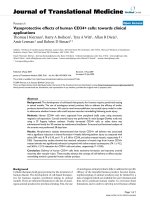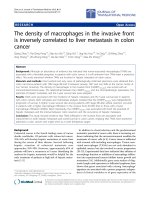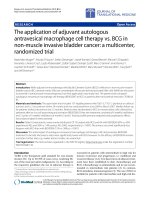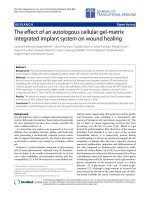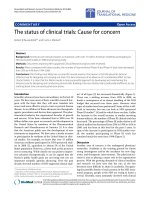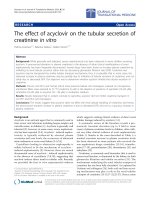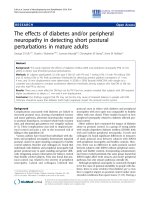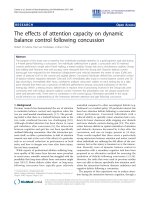Báo cáo hóa học: " The effects of attention capacity on dynamic balance control following concussion" doc
Bạn đang xem bản rút gọn của tài liệu. Xem và tải ngay bản đầy đủ của tài liệu tại đây (357.5 KB, 8 trang )
RESEARC H Open Access
The effects of attention capacity on dynamic
balance control following concussion
Robert D Catena, Paul van Donkelaar, Li-Shan Chou
*
Abstract
The purpose of this study was to examine how individuals modulate attention in a gait/cognition dual task during
a 4-week period following a concussion. Ten individuals suffering from a grade 2 concussion and 10 matched
controls performed a single task of level walking, a seated auditory Stroop task and a simultaneous auditory Stroop
and walking task. Reaction time and accuracy were measured from the Stroop task. Dynamic balance control
during gait was measured by the interaction (displacement and velocity) between the center of mass (CoM) and
center of pressure (CoP) in the coronal and sagittal planes. Concussed individuals shifted from conservative control
of balance (shorter separation between CoM and CoP) immediately after injury to normal balance control over 28
days post-injury. Immediately after injury, correlations analyses using each subject on each testing day as a data
point showed that there was a spectrum of deficient performance among concussed individuals on the first
testing day. Within a testing session, deficiencies in reaction time of processing involved in the Stroop task were
commonly seen with reduce dynamic balance control. However, the prioritization was not always towards the
same task between trials. There were no correlations in the control group. Information provided in this study
would enhance our understanding of the interaction between attention and gait following concussion.
1. Background
Previous research has demonstrated the use of attention
to modulate balance control and cognition when the
two are used/needed simultaneously [1-7]. The prevail-
ing belief is that there is a tradeoff between tasks as the
two tasks combined become too challenging [8,9].
Although divided attention has been shown to cause
gait imbalance after concussio n [5], the interaction
between cognition and gait has not been specifically
outlined following concussion. How this interaction pre-
sents itself, as eithe r a prioritization (a shift of attention
towards one task at the cost of the other) of a particular
task or an overall reduction in performance in both
tasks, and how it changes over time after brain injury,
has not been examined.
While reports of professional athletes suffering long-
term quality of life i ssues have become more prevalent
in recent years, scientific research has struggled with the
possibility that long-term effects from concussion might
exist [10-12]. Motor deficits, either short- or long-term,
following concussion have typically gone relatively
unstudied compared to other neurological deficits (e.g.
Parkinson’s or cerebral palsy). Of particular interest has
bee n how attention deficits following a concussio n alter
motor performance. Concussed individuals with a
reduced ability to spatially orient attention had a ten-
dency for lower clearances while stepping over obstacle
and more obstacle contacts during gait [13]. The inter-
action between deficits in spatial orientation of attention
and obstacle clearance decreased by 6 days after the
concussion, and was no longer present at 14 days.
These results implied that there exists a particularly
strong interaction between attention and motor control
when individuals are suffering the full effects of the con-
cussion, but as the injury is transient so is the interac-
tion. Recently, tests of dynamic balance control in
conjunction with a secondary cognitive task have been
proposed as an alternative method for assessing the
resolution of deficits fo llowing concussion [1,2,14].
However, the tasks that were used in previous studies
were not able to discern specifically how attention mod-
ulates the interaction between dynamic imbalance and
cognitive deficits following a concussion.
The purpose of this experiment was to analyze atten-
tion during the interaction between cognition, through a
* Correspondence:
Motion Analysis Laboratory, Department of Human Physiology, University of
Oregon, 97403 Eugene, Oregon, USA
Catena et al. Journal of NeuroEngineering and Rehabilitation 2011, 8:8
/>JNER
JOURNAL OF NEUROENGINEERING
AND REHABILITATION
© 2011 Catena et al; licensee BioMed Cent ral Ltd. This is an Open Access article distributed under the terms of the Creative Commons
Attribution License ( which permits unrestricted use, distribution, and reproduction in
any medium , provided the original work is properly cited.
Stroop reaction time task, and dynamic balance control
following a concus sion. An interaction was hyp othesized
based on well-understood data in healthy individuals
[15,16], but how exactly this will present itself following
a concussion is unknown. This research will indicate
how concussed patients resolve issues with performing a
dual-task involving an executive functioning measure
and gait. Information from this study will also help us
understand the influence of attention capacity deficits in
a limited-capacity system since previous studies with
similarly rigorous dual tasks have been dually examined,
but not dually quantified.
2. Methods
2.1 Subjects
Twenty young adults participated in this study. Subjects
were divided into two groups: ten subjects suffering
from concussion or mild traumatic brain injury (mTBI)
and ten controls without injury (Cont). The experimen-
tal protocol was approved by the Institutional Review
Board at the University of Oregon. Written and verbal
instructions of testing procedures were provided, and
written consent was obtained from each subject prior to
testing.
Participants suffering from a grade 2 concussion (5
females/5 males; age = 21.0 ± 3.1 years; body mass = 71.7
± 10.5 kg; height = 173.6 ± 11.5 cm) were initially
rec ruited for testing within two days following the injury
after being identified and diagnosed by certified athletic
trainers and/or attending medical doctors in the univer-
sity intercollegiate athletic program or the student health
center. Subsequent testing occurred 6, 14 and 28 days
after the injury. The severity of the injury was categorized
by the attending certified athletic trainers and/or medical
doctors in accordance with the definitions originated by
the American Academy of Neurology [17]. During the
initial medical diagnosis, a grade of “ 2” was assigned if
the participant remained disoriented for greater than
15 minutes, but did not lose consciousness for any period
of time. A ll participants were re-evaluated by a single
researcher about their symptoms and diagnosis when
arriving for their first testing to confirm that they did suf-
fer a grade 2 concussion. All concussion participants
were asked to fill out a questionnaire of symptoms, and a
range of symptoms and severit ies wer e recorded without
a clear pattern or trend. Age-, gender-, athletic ability
(sport)-, education level-, height- and body mass-
matched (age = 20.7 ± 4.1 years; body mass = 72.6 ± 10.5
kg; height = 172.7 ± 11.6 cm) control participants were
recruited and tested for the same intervals. Injuries/disor-
ders that prevented normal gait (e.g. exhaustion, sprains,
and ataxia) were exclusion criteria applied to all subjects
and common symptoms of concussion were exclusion
criteria applied to control individuals.
2.2 Experimental protocol
Participants performed: (1) single-task level walking,
(2) a seated auditory Stroop task and (3) walking with
an auditory Stroop task. The auditory Stroop task
required the participant to listen to a computer pre-
sented word ("high” or “low” )thatwaspresentedin
either a high or low pitch. The objective of the subject
was to alway s declare the pitch of the word while ignor-
ing the word itself. Congruent (where the pitch matches
the word) and incongruent (where the pitch doesn’t
match the word) conditions were examined separately
to measure the Stroop effect, and analyzed together to
analyze attentional capacity. Blocks of four seated Stroop
trials were performed before and after walking trials.
Walking trials were performed in blocks of eight trials
for single- and dual-task. The order of walking trials
was randomized for each subject and each day. Several
minutes of rest were provided between blocks. Walking
was performed along a 10 m walkway at a self-selec ted
pace. During Stroop walking, a single stimulus was pre-
sented at the beginning of the analyzed motion data of
one complete stride. Subjects were informed about the
impending task at the beginning of each block of trials.
2.3 Experimental apparatus
Twenty-nine retro-reflective markers, modified from the
Helen Hayes marker set [14], wer e placed on anatomical
landmarks. Three dimensional marker trajectories were
collected with an eight camera motion tracking system
(Motion Analysis Corp., Santa Rosa, CA) at a sampling
frequency of 60 Hz. Ground reaction forces and
moments in t hree orthogonal directions were collected
at a sampling rate of 960 Hz with two in-series strain
gauge force plates (Advanced Mechanical Technologies
Inc. Watertown, MA) flush with the top surface of the
floor in the center of the walkway. Stroop stimuli were
presented in random order using SuperLab Pro (Cedrus
Corp. San Pedro, CA). Responses were recorded with
Motion Analysis software.
2.4 Data Processing
Besides recording response accuracy, we also analyzed
reaction times during the Stroop task with a radio-
telemetric microphone. Voice recordings were collected
at 960 Hz. Visual inspections by a single examiner
determined the onset of all responses. F or the gait ana-
lysis, marker trajectories were filtered with a low-pass
fourth order Butt erworth filter at a cutoff frequency of
8 Hz. Marker position data were used to locate the seg-
mental centers of mass (CoM) of a thirteen-link model
based on Dempster’ s [18] ant hropometric data. A
weighted sum method was used to calculate the whole
body CoM from segmental CoMs during each time
point. CoM data were analyzed between the first heel
Catena et al. Journal of NeuroEngineering and Rehabilitation 2011, 8:8
/>Page 2 of 8
strike on to the first force plate to the next heel strike of
the same f oot. CoM ve locities were estimated with the
use of Woltring’s generalized cross-validated spline algo-
rithm [19]. Center of pressure (CoP) was calculated
using the ground reaction forces/moments measured
with the two force plates. The CoP data were then time-
synchronized with the motion data. During the double
stance phase, a resultant CoP was calculated for both
feet using the CoP and vertical ground reaction force
from each foot. Inclination angles were calculated as the
angle from the CoM, down to the CoP and b ack up to
the vertical (Figure 1). Peak inclination angles in the
sagittal and coronal plane were identified during a gait
cycle. The posterior and anterior peak angles were then
summed to find a sagittal plane angular range of motion
(SR). The medial peak angle from t he left foot was
summedtothatoftherightfoottofindafrontalplane
angular range of motion (FR). Peak CoM velocities in
both the sagittal and frontal plane (SV, FV) were also
calculated. These balance control variables have been
used previously to identify balance control deficits in
individuals with a history of falling [20].
2.5 Statistical analyses
A three-way mixed model analysis of variance with
repeated measures (alpha = 0.05) was conducted on
each variable using SPSS v.12 (SPSS Inc., Chicago, IL).
Testing day and task were within-subject factors and
group was a between-subject factor. Previously described
balance control and Stroop variables were dependant
variables of interest. The appropriate assumptions for
both within and between subjects ANOVA were consid -
ered. Pairwise comparisons in the three way interaction
were analyzed with adjustments for multiple compari-
sons (alpha = 0.05/8 = 0.00625), while other pairwise
comparisons were analyzed with Least Significant Differ-
ence adjustments for multiple comparisons.
To analyze how each group altered one task perfor-
mance with respect t o the other in the dual-task
situation we calculated correlations between the means
of balance variables and Stroop reactions times with lin-
ear regressions for each group and day (alpha = 0.05).
To analyze how each individual altered one task perfor-
mance with respect to other in the dual-task situation
we calculated correlation coefficients for each individual
and then conducted t-tests on individual correlation
coefficients between groups (alpha = 0.05).
3. Results
3.1 Group comparisons of Stroop and balance
performance
Analyses of Stroop reaction time separated by group,
testing day and task specifics (congruent vs. incongruent
Stroop task or motor task) indicated no statistically sig-
nificant differences during seated (p = 0.556) or walking
trials (p = 0.735). The average reaction time varied
between 777 ms and 1019 ms depending on the group,
testing day and task specifics, with no clear trends.
There were also no statistical differences in response
accuracy as there were never any incorrect responses.
Both peak anterior CoM velocity and angular range of
motion in the sagittal plane indicated group*day interac-
tions (p =0.004andp = 0.015, respectively) and task
differences (p = 0.003 and p = 0.021, respectively).
Group*day interactions indicated that only concussed
individuals walked with significantly slower sagittal CoM
motion (Figure 2) and allowed less sagittal plane CoM-
CoP angular separation (Figure 3) on the first testing
day compared to all o ther testing days. Both groups
walked with significantly slower peak velocities and
allowed significantly less sagittal plane CoM-CoP
separation during single task walking compared to
Stroop walking.
Figure 1 Center of mass (as the head of the inverted
pendulum) to center of pressure inclination angles in the
(A) sagittal and (B) frontal planes.
1.2
1.25
1.3
1.35
1.4
1.45
1.5
1.55
1.6
1.65
1
.7
0 5 10 15 20 25 3
0
Anterior peak velocity (m/s)
testin
g
da
y
Cont
mTBI
a, b
Figure 2 Anterior peak velocity of center of mass over 28 days
of testing for each group. Controls are represented by the dashed
line. Concussed are represented by the solid line. Standard error
bars are presented. (a) Indicates a trend of statistical difference (p =
0.064) between the two groups on a particular day. (b) Indicates
statistical difference (p = 0.001) from all other days in a particular
group.
Catena et al. Journal of NeuroEngineering and Rehabilitation 2011, 8:8
/>Page 3 of 8
Analysis of variance on frontal plane angular range of
motion of the CoM (Figure 4) indicated a group*day*-
task interaction (p = 0.003). The concussed group in
generaltendedtohavemorefrontalplanemotionthan
controls during gait, but specifically showed increased
motion during congruent Stroop walking on the day 14
testing (p = 0.006). This difference was not due to the
fact that control individuals changed, as they did not
have any statistical difference between days, but because
concussed individuals had increased frontal plane
motion during congruent Stroop walking on day 14
compared to day 7 (p = 0.002) and day 28 (p < 0.001)
post-injury. Frontal plane motion in the concussed indi-
viduals during congruent Stroop walking on the day 14
testing was also significantly greater than single-task
walking on the same day (p = 0.003). There were no sta-
tistically significant differences in peak medial velocity of
the CoM.
3.2 Correlation analyses of Stroop and balance at the
group and individual level
Control individuals demonstrated no correlation
between sagittal plane motion and Stroop performance.
On the other hand, concussed individuals showed signif-
icant moder ate correlations between sagittal plan e
motion and Stroop performance during gait 48 hours
after injury (R
2
= .411, p = 0 .046), which reduced to
non-significant levels on the subsequent testing days.
The relationship showed that concussed individuals who
displayed shorter sagittal plane CoM-CoP angles had
longer reaction times in the Stroop task (Figure 5).
When specifically looking within each individual we
found that seven of the ten concussed individuals dis-
played a positive correlation between Stroop reaction time
deficits and sagittal angular range of motion on a trial-by-
trial basis 48 hours after injury, indicating increased defi-
cits in one task may correlate with increase deficits in the
other task. The correlation coefficients for concussed indi-
viduals were statistically different than control individuals
who displayed no correlation (n = 4) or the opposite cor-
relation (n = 5) within most individuals (p = 0.048). There
were no statistical d ifferences between the correlation
coefficients of each group on subsequent testing days. By 6
and 14 days post-concussion only one individual was still
exhibiting this shift in prioritization between trials. By 28
days, he performed similar to controls.
4. Discussion
This research examined attention prioritization (a shift
of attention towards one task at the cost of the other)
between dynamic balance control and cognitive perfor-
mance. Information was used to estimate if and how
attention capacity deficits and/or executive functioning
following concussion affect dual task performance.
4.1 Executive functioning
Executive function is a higher level manager of other
cognitive processes. One of its subtasks is conflict reso-
lution, which allows us to ignore conflicting information
to choose an appropriate response. It has been sug-
gested that balance deficits c ould be due to an interac-
tion with executive functioning deficits in certain
pathological groups, including traumatic brain injury
[21]. This was not indicated in the current study
because there were no clear differences in the effects of
20
21
22
23
24
25
26
2
7
0 5 10 15 20 25 30
S
agittal R
O
M
(
degrees
)
testin
g
da
y
Cont
mTBI
a, b
Figure 3 Sagittal plane angular range of motion of the cent er
of mass with respect to the center of pressure over 28 days of
testing. Controls are represented by the dashed line. Concussed are
represented by the solid line. Standard error bars are presented. (a)
Indicates statistical difference (p = 0.041) between the two groups
on a particular day. (b) Indicates statistical (p = 0.001) from all other
days in a particular group.
5.5
6
6.5
7
7.5
8
0 5 10 15 20 25 30
Medial ROM (degrees)
testin
g
da
y
mTB
I
Cont.
a
Figure 4 Medial angular range of motion of center of mass
with respect to center of pressure over 28 days of testing.
Concussed subjects are represented by “mTBI” to the right of the
graph and control subjects are represented by “Cont.” Solid lines
represent single task walking, short-dashed lines represent Stroop
walking during congruent task presentation and long-dashed lines
represent Stroop walking during incongruent task presentation.
(a) Indicates statistical difference (p < 0.00625) between the two
groups for congruent Stroop walking on day 14.
Catena et al. Journal of NeuroEngineering and Rehabilitation 2011, 8:8
/>Page 4 of 8
congruency on balance control. The single possible indi-
cation of an executive function interaction with dynamic
balance control following concussion occurred at the
day 14 testing. Concussed individuals p erforming a
congruent Stroop task had more coronal plane motion
than when they were performing single task walking.
Incongruent Stroop walking did not result in the same
increased coronal plane motion. However, since there
Figure 5 Correlation between sagittal plane angular range of motion of the CoM with respect to the CoP and Stroop reaction time
for concussed and control individuals on each testing day. Each point represents the mean performance of a single individual.
Catena et al. Journal of NeuroEngineering and Rehabilitation 2011, 8:8
/>Page 5 of 8
was no statistical difference between congruency condi-
tionsthenthisisonlyaspeculativedifferenceuntil
further studies can shed more light on this partic ular
trend. We have no definitive explanation for day 14
findings; however a r eoccurrence of balance deficits has
been previously found and explained by a return to
sport and activity too soon [5].
4.2 Attention Capacity
Cognition - gait balance control interactions were much
more obvious in this study as demonstrated by the fact
that concussed individuals who had slower reaction
times overall in the Stroop task also used a more cau-
tious gait strategy (as indicated by decreased CoM-CoP
inclination). A similar conservative gait strategy has
been found in mild [1,2,4,5] and more severe [22,23]
brain-injured individuals. These changes are thought to
be an effort to reduce the CoM forward momentum
during gait progression [24,25] and may indicate a
degraded ability to maintain gait stability in individuals
suffering from a concussion. While the reduction serves
the mechanical purpose of making balance in the sagit-
tal plane easier to maintain, it still remains unclear if
these are inherent or conscious adjustments made by
the individual. The finding of deficits in rea ction time in
concert with the conservative gait strategy in certain
individuals points to concussion being a broad reduction
in performance rather than isolated to specific areas.
Similar to the transient nature of concussion, these defi-
ciencies in dual-task performance gradually subsided.
The spread in performances indicates that within the
group of concussed individuals there are individuals that
may be more impaired than others. Those that possibly
suffered more impairment appeared to have a general
cognitive deficit along with an average slowing of motor
performance in the dual-task situation compared to
those that may have more mild injury or may at the
time be completely recovered. This is supported by find-
ings that severely brain injured individuals performed
poorly in postural control while at the same time com-
mitting more arithmetic errors in a dual-task paradigm
[3]. This information, from a group of individuals
assigned the same concussion grade, shows the impor-
tance of diagnosing a concussion beyond simple grading
scales that categorize patients of varying severity into
the same group. This interaction was only statistically
evident in the first testing session, after which it gradu-
ally decreased. Presumably, this is due to the recovery
from the effects of concussion that individuals suffered
soon after the injury. The fact that first testing session
correlations were not near perfect correlations indicates
that using balance control as the sole indicator for
determining an athlete’s readiness to resume competitive
activity after injury is not recommended.
In the analysis of individual concussed participants we
looked at trends in balance/cognition i nteractions
between trials for each individual. We then used that
information to distinguish between concussed and con-
trol individuals. With in each concussed individual
(between trials) on the first testing day we found that
most individuals had a trade-off, or prioritization, in
performance of tasks in the dual-task situation. For cer-
tain trials they had quicker reaction times with more
cautious sagittal plane motion and for other trials they
had slower reaction times with less cautiou s gait perfor-
mance. This interaction was not seen in control indivi-
duals in the first testing session and in three concussed
individuals it was not present. We can only explain a
lack of prioritization shifts between trials not present in
three concussed individuals by a lack of deficits in con-
trol of prioritization (similar to controls) for these indi-
viduals. This may be due to severity or recovery rates
differing among individuals. In subsequent testing ses-
sions there were no statistical differences between how
concussed and control individua ls varied secondary task
performance with walking strategy.
This interaction and resultant trade-off has not been
previously examined in concussed individuals during a
dynamic motor task, but it is similar to what healthy
individuals have displayed in coordination/reaction time
tasks [15,16]. The fact that we did not observe this
trade-off in control individuals f or the particular para-
digm used in this study is promising in that it might
indicate that the dual-task scenario is particularly sensi-
tive to the effects of concussions. Trade-offs in task per-
formances seem to be a result of limited attentional
resources indicated in the group correlations, similar to
previous findings [15]. As attention resources diminish,
two tasks that were was once sim ply performed simulta-
neously without any degraded performance (as in con-
trols) now compete for attention to be accomplished at
all. The fact that these interactions are apparent only
immediately after concussion are particularly noteworthy
since our previous research has shown dual-task balance
deficits immediately after concussion [1,2,4,5], but
slowly subsiding thereafter [5].
Interestingly, the prioritization to a particular task that
a concussed individual showed in one trial was not
necessarily the same t hat they would use for the next
trial (i.e. prioritization shifted between tasks). There
were no clear trends in how the prioritization shifted
within a testing session, but we would recommend that
this be investigated further with an increased sample of
trials. Individuals have previously exhibited a prioritiza-
tion of a balance control in a dual task situation [7].
This “posture first hypothesis” indicates that indivi duals
would prioritize control of balance before another safer
task [26]. The fact that concussed individuals shifted
Catena et al. Journal of NeuroEngineering and Rehabilitation 2011, 8:8
/>Page 6 of 8
prioritization between tasks during separate trials would
seem to indicate they did not fully comprehend their
poor control over balance and/or were unable to appro-
priate focus attention on the walking task. As previously
stated, current informationontheprioritizationof
attention following concussions is lacking. This informa-
tion would be helpful in understanding the interaction
between cognition and motor control. This current
study was unable to detect trends in prioritization fol-
lowing concussion, which actually is useful information
given the frequently exhibited prioritization on balance
control in healthy individuals. This information may
prove useful in future developments of secondary mea-
sures of a persisting brain injury.
4.3 Limitations
There were limitations sources in this study beyond
those already described in the discussion. Baseline infor-
mation would have been a more reliable source for
comparison of deficits as a result of concussion. The
inclusion of a motor task makes baseline information
very difficult to obtai n. Making group comparison s with
control individuals was a major source of variability.
Sampl e size is an obvious concern with our strict exclu-
sion criteria. A lack of statistical power may have made
certain findings a ppear to lack a statistical significance
(e.g. Stroop reaction times) when an increased sample
size would have found differently. Furthermore, a lim-
ited number of Stroop trials per block increased varia-
bility in reaction times within individuals. It seemed that
an auditory Stroop task was more variable than a visual
Stroop reaction time usually employed. When used as a
secondary task in a dual-task scenario, the auditory
Stroop task can provide the desired rigor, but unfortu-
nately also requires additional trials to make mo re con-
crete conclusions in its performance when analyzed with
an ANOVA test.
5. Conclusions
Even though attention deficits have been previously
shown to be related to balance control after concussion,
there were few indications that dynamic balance control
was affected by executive function deficits. However, it
should be noted that deficits were not even noted in the
seated trials, possibly indicating the inappropriateness of
the task for measuring executive functioning following
concussion. On the other hand, changes in gait due to
concussion were evident in individuals that also had
slower reaction times in the secondary Stroop task.
While analyses of the concu ssed group as a whole indi-
cates that those that have deficits in one task also suffer
deficits in the other, the analyses of inter-trial task per-
formances within the concussed group showed most
individuals used a trade-off in t ask performances while
controls did not show this trend. This only occurred on
the first testing day. This information points to atten-
tional capacity deficits as a possible contributor to gait
abnormalities following a concussion.
Acknowledgements
This study was supported by the Center for Disease Control and Prevention
(R49/CCR021735 and CCR023203). The authors gratefully acknowledge the
assistance of Louis R. Osternig, Jacqueline Poston and Erik Noren.
Authors’ contributions
All authors have made substantial contributions to study conception and
design. RDC took the primary responsibility in data collection, processing
and analysis, with the assistance from LSC and PVD. RDC and LCS performed
interpretation on findings and drafted the manuscript. All authors read,
provided comments and suggestions, and approved the manuscript.
Competing interests
The authors declare that they have no competing interests.
Received: 28 April 2010 Accepted: 3 February 2011
Published: 3 February 2011
References
1. Catena RD, van Donkelaar P, Chou L-S: Altered balance control following
concussion is better detected with an attention test during gait. Gait
Posture 2007, 25:406-411.
2. Catena RD, van Donkelaar P, Chou L-S: Cognitive task effects on gait
stability following concussion. Exp Brain Res 2007, 176(1):23-31.
3. Geurts AC, Ribbers GM, Knoop JA, van Limbeek J: Identification of static
and dynamic postural instability following traumatic brain injury. Arch
Phys Med Rehabil 1996, 77(7):639-644.
4. Parker TM, Osternig LR, Lee HJ, van Donkelaar P, Chou L-S: The effect of
divided attention on gait stability following concussion. Clin Biomech
2005, 20:389-395.
5. Parker TM, Osternig LR, van Donkelaar P, Chou L-S: Gait stability following
concussion. Med Sci Sports Exerc 2006, 38(6):1032-1040.
6. van Donkelaar P, Osternig L, Chou LS: Attentional and biomechanical
deficits interact after mild traumatic brain injury. Exerc Sport Sci Rev 2006,
34(2):77-82.
7. Siu KC, Catena RD, Chou LS, van Donkelaar P, Woollacott MH: Effects of a
secondary task on obstacle avoidance in healthy young adults.
Experimental Brain Research 2008, 184(1):115-120.
8. Montero-Odasso M, Casas A, Hansen KT, et al: Quantitative gait analysis
under dual-task in older people with mild cognitive impairment: a
reliability study. J Neuroeng Rehabil 2009, 6:35.
9. Siu KC, Lugade V, Chou LS, van Donkelaar P, Woollacott MH: Dual-task
interference during obstacle clearance in healthy and balance-impaired
older adults. Aging Clin Exp Res 2008, 20(4):349-354.
10. Heitger MH, Jones RD, Frampton CM, Ardagh MW, Anderson TJ: Recovery
in the first year after mild head injury: divergence of symptom status
and self-perceived quality of life. J Rehabil Med 2007, 39(8):612-621.
11. Kuehl MD, Snyder AR, Erickson SE, McLeod TC: Impact of prior concussions
on health-related quality of life in collegiate athletes. Clin J Sport Med
2010, 20(2):86-91.
12. Solomon GS, Johnson KM, Lovell MR: The Heads-Up on Sport Concussion.
Champaign, IL: Human Kinetics; 2006.
13. Catena RD, van Donkelaar P, Halterman CI, Chou LS: Spatial orientation of
attention and obstacle avoidance following concussion. Experimental
Brain Research 2009, 194(1):67-77.
14. Catena RD, van Donkelaar P, Chou L-S: Different gait tasks distinguish
immediate vs. long-term effects of concussion on balance control. J
NeuroEng Rehab 2009, 6:25.
15. Matthews A, Garry MI, Martin F, Summers J: Neural correlates of
performance trade-offs and dual-task interference in bimanual
coordination:
an ERP investigation. Neurosci Lett 2006, 400(1-2):172-176.
16. Temprado JJ, Monno A, Laurent M, Zanone PG: A dynamical framework to
understand performance trade-offs and interference in dual tasks. J Exp
Psychol Hum Percept Perform 2001, 27(6):1303-1313.
Catena et al. Journal of NeuroEngineering and Rehabilitation 2011, 8:8
/>Page 7 of 8
17. American Academy of Neurology: Practice parameter: the management
of concussion in sports [summary statement]. Neurology 1997, 48:581-585.
18. Winter DA: Biomechanics and Motor Control of Human Movement. New
York: Wiley-Interscience;, 2 1990.
19. Woltring HJ: A FORTRAN package for generalized, cross-validatory spline
smoothing and differentiation. Adv Eng Softw 1986, 8:104-113.
20. Lee HJ, Chou LS: Detection of gait instability using the center of mass
and center of pressure inclination angles. Arch Phys Med Rehabil 2006,
87(4):569-575.
21. Fait P, McFadyen BJ, Swaine B, Cantin JF: Alterations to locomotor
navigation in a complex environment at 7 and 30 days following a
concussion in an elite athlete. Brain Injury 2009, 23(4):362-369.
22. Chou LS, Kaufman KR, Walker-Rabatin AE, Brey RH, Basford JR: Dynamic
instability during obstacle crossing following traumatic brain injury. Gait
Posture 2004, 20:245-254.
23. McFadyen BJ, Swaine B, Dumas D, Durand A: Residual effects of a
traumatic brain injury on locomotor capacity: a first study of
spatiotemporal patterns during unobstructed and obstructed walking. J
Head Trauma Rehabil 2003, 18(6):512-525.
24. Hahn ME, Chou L-S: Age-related reduction in sagittal plane center of
mass motion during obstacle crossing. J Biomech 2004, 37:837-844.
25. Kaya BK, Krebs DE, Riley PO: Dynamic stability in elders: momentum
control in locomotor ADL. J Gerontol 1998, 53(2):M126-134.
26. Shumway-Cook A, Woollacott M, Kerns KA, Baldwin M: The effects of two
types of cognitive tasks on postural stability in older adults with and
without a history of falls. J Gerontol A Biol Sci Med Sci 1997, 52(4):
M232-240.
doi:10.1186/1743-0003-8-8
Cite this article as: Catena et al.: The effects of attention capacity on
dynamic balance control following concussion. Journal of
NeuroEngineering and Rehabilitation 2011 8:8.
Submit your next manuscript to BioMed Central
and take full advantage of:
• Convenient online submission
• Thorough peer review
• No space constraints or color figure charges
• Immediate publication on acceptance
• Inclusion in PubMed, CAS, Scopus and Google Scholar
• Research which is freely available for redistribution
Submit your manuscript at
www.biomedcentral.com/submit
Catena et al. Journal of NeuroEngineering and Rehabilitation 2011, 8:8
/>Page 8 of 8

